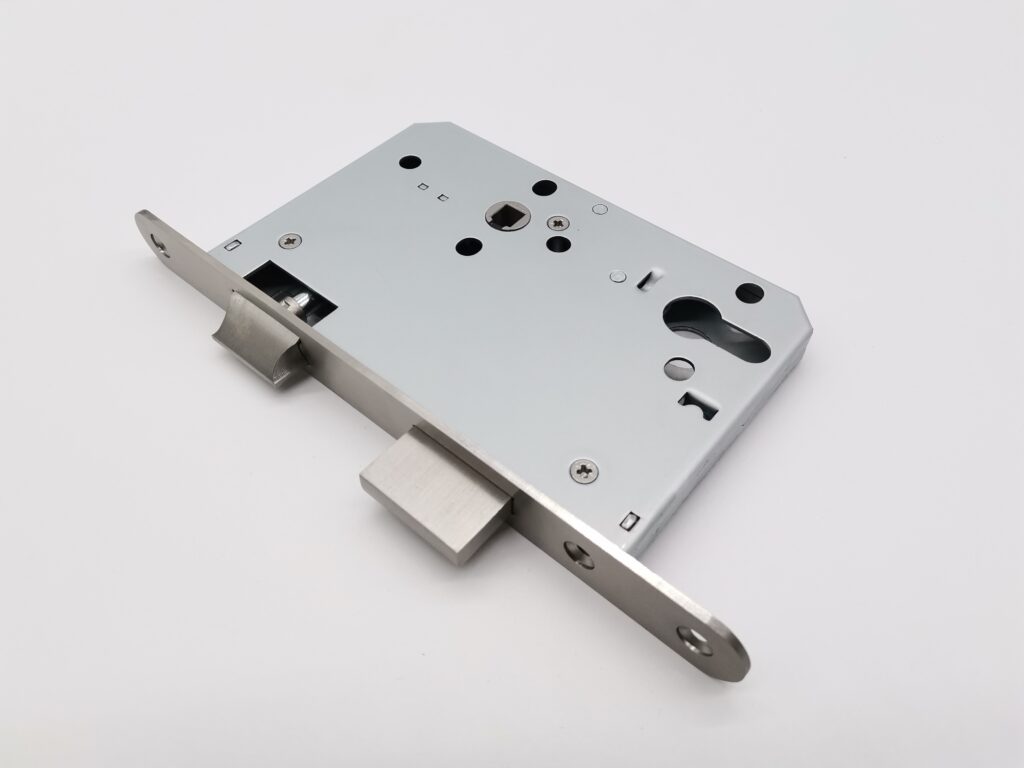In an era where security and design harmonize to define modern living spaces, Euro profile mortise locks have emerged as a cornerstone of both residential and commercial door hardware. These locks, characterized by their concealed installation and robust engineering, blend advanced security features with sleek aesthetics, making them a preferred choice globally. Originating from European architectural standards, they now dominate high-security markets worldwide due to their adaptability and reliability.
What Is a Euro Profile Mortise Lock?
A Euro profile mortise lock is installed within a recess (mortise) carved into the door edge, ensuring minimal visibility when closed. Its design centers on a standardized “Euro cylinder” lock core, which can be easily replaced without altering the entire lock system—ideal for security upgrades or key management24. The term “Euro profile” refers to the lock’s compatibility with European-standardized dimensions, enabling seamless integration across diverse door types, including wood, metal, and uPVC.

Main Materials
Euro mortise locks prioritize durability and resistance to tampering:
Stainless Steel (SUS304): Stainless steel has excellent corrosion and oxidation resistance and is suitable for use in a wide range of environments, especially excelling in wet or highly corrosive environments.
Advantages
- Enhanced Security:Mortise locks often feature multiple locking points, including deadbolts, which offer an extra layer of defense against break-ins.
- Superior Strength and Durability: Mortise locks are built to last. It is installed in a recess (or mortise) cut into the door and is not easily broken. For use on external doors with equal height.
- Aesthetically Versatile: Available in various finishes such as brass, chrome, and satin nickel, mortise locks can complement any interior or exterior door design.
- Ideal for Commercial Use: Mortise locks are commonly used in commercial settings due to its security.
- Compliance with Safety Standards: Most mortise locks meet safety and performance standards,
- Most mortise locks meet or exceed safety and performance standards. Many models are fire-rated.

The Working Principle of Mortise Locks
Latch Bolt
The latch bolt realizes the switch function through the compression and reset of the latch bolt reset spring, mainly used for temporary locking.
- Turning the handle: press down the handle to turn the follower, drive the fork paddle and the latch bolt dial plate, so that the latch bolt retracted into the lock body; release the handle, the spring reset, the latch bolt pop out to realize the closure.
- Turn the lock cylinder: use the key to turn the lock cylinder, push the cam to drive the latch bolt toggle to make the latch bolt indented; release the key, the spring reset, the latch bolt pop out to realize the closure.
- Door frame compression: when closing the door frame external force compression of the latch bolt, so that it naturally closed.
Dead Bolt
Dead bolt realizes opening and closing by turning the lock cylinder, and plays a real locking role.
- Locked state: no cylinder cam, the lock plate under the action of the spring fixed dead bolt, can not move.
- Open: rotate the cylinder cam, lift up the locking plate, push the dead bolt out of the lock body.
- Close: reverse movement to make the dead bolt retracted.
Important dimensions on the lock body
(1) C-C distance: the distance from the center of the handle to the center of the cylinder, the most common are 85mm, 72mm, 70mm. 85mm for Russia and Italy, 72mm for Germany, 70mm for France.


(2) Backset: the distance from the center of the lock cylinder to the panel, commonly used side distance of 30mm, 35mm, 45mm, 55mm, 60mm, 65mm, of which 45mm is the most common standard side distance. Less than 45mm called narrow body lock, mainly used for aluminum doors or plastic doors.
Holes in the lock body
The holes to the left and right of the follower are for the handle counter-screws, the holes to the left and right of the lock cylinder (usually 38mm center to center of the counter-screw holes) are for the mounting screws, and the holes underneath are for the installation of the lock cylinder protector.
Application
- Residential: Ideal for modern homes prioritizing sleek design and high security. Often be used in internal and external doors.
- Commercial: Offices, hotels, and hospitals benefit from noise-free operation and fire-rated options (e.g., SDH’s mortise locks).
- Luxury Real Estate: High-end projects leverage premium brands like Tectus (Germany) for bespoke finishes.
- Functional Usage: Anti-panic doors, classroom doors, bathroom doors and X-ray doors.

How to Choose Mortise Locks
When it comes to securing your home or business, the mortise lock is a popular choice for its strength, reliability, and sleek design. The following will show how to select the right one for your needs.
- Consider the material and build quality. A solid brass or steel lock provides long-lasting durability and resistance to tampering.
- Security. Lock with multiple locking points, as these offer better protection against forced entry.
- Style. Mortise locks come in various finishes, such as polished chrome, satin nickel, or antique brass, allowing you to match the aesthetic of your space.
- Keyway! Choose a lock with a high-security key system.
- Ease of installation. Some mortise locks may require professional installation, while others are DIY-friendly. Choose one that fits your comfort level.Or please contact SDH for professional instruction.
By focusing on material, security, style, and functionality, you’ll be able to select the perfect mortise lock to keep your property safe and stylish.
Conclusion
Euro profile mortise locks exemplify the fusion of security and sophistication. Their adaptability to evolving architectural trends and resilience against threats position them as indispensable in modern security systems. For those seeking to elevate safety without sacrificing style, these locks are not just an investment—they are a statement of refined practicality.From the current situation of the lock market, it will still be dominated by mechanical locks . It has a wide range of applications.
SDH offers different types of mortise locks, please contact us for more information.


